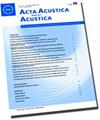Solving Galbrun's Equation with a Discontinuous galerkin Finite Element Method
Q1 Arts and Humanities
引用次数: 1
Abstract
Over many years, scientists and engineers have developed a broad variety of mathematical formulations to investigate the propagation and interactions with flow of flow-induced noise in early-stage of product design and development. Beside established theories such as the linearized Euler equations (LEE), the linearized Navier–Stokes equations (LNSE) and the acoustic perturbation equations (APE) which are described in an Eulerian framework, Galbrun utilized a mixed Lagrange–Eulerian framework to reduce the number of unknowns by representing perturbations by means of particle displacement only. Despite the advantages of fewer degrees of freedom and the reduced effort to solve the system equations, a computational approach using standard continuous finite element methods (FEM) suff ers from instabilities called spurious modes that pollute the solution. In this work, the authors employ a discontinuous Galerkin approach to overcome the difficulties related to spurious modes while solving Galbrun's equation in a mixed and pure displacement based formulation. The results achieved with the proposed approach are compared with results from previous attempts to solve Galbrun's equation. The numerical determination of acoustic modes and the identification of vortical modes is discussed. Furthermore, case studies for a lined-duct and an annulus supporting a rotating shear-flow are investigated.用不连续galerkin有限元法求解Galbrun方程
多年来,科学家和工程师已经开发了各种各样的数学公式来研究流动噪声在产品设计和开发早期的传播和与流动的相互作用。除了在欧拉框架中描述的线性化欧拉方程(LEE)、线性化纳维-斯托克斯方程(LNSE)和声摄动方程(APE)等已建立的理论外,Galbrun利用混合拉格朗日-欧拉框架通过仅用粒子位移表示摄动来减少未知数的数量。尽管使用标准连续有限元法(FEM)的计算方法具有自由度更少和求解系统方程的工作量更少的优点,但它存在被称为伪模态的不稳定性,从而污染了解。在这项工作中,作者采用不连续伽辽金方法来克服在混合和纯基于位移的公式中求解Galbrun方程时与伪模态相关的困难。本文将所提出的方法与以往求解Galbrun方程的方法进行了比较。讨论了声模态的数值确定和涡模态的识别。此外,还研究了内衬管道和支撑旋转剪切流的环空的实例。
本文章由计算机程序翻译,如有差异,请以英文原文为准。
求助全文
约1分钟内获得全文
求助全文
来源期刊
CiteScore
2.60
自引率
0.00%
发文量
0
审稿时长
6.8 months
期刊介绍:
Cessation. Acta Acustica united with Acustica (Acta Acust united Ac), was published together with the European Acoustics Association (EAA). It was an international, peer-reviewed journal on acoustics. It published original articles on all subjects in the field of acoustics, such as
• General Linear Acoustics, • Nonlinear Acoustics, Macrosonics, • Aeroacoustics, • Atmospheric Sound, • Underwater Sound, • Ultrasonics, • Physical Acoustics, • Structural Acoustics, • Noise Control, • Active Control, • Environmental Noise, • Building Acoustics, • Room Acoustics, • Acoustic Materials and Metamaterials, • Audio Signal Processing and Transducers, • Computational and Numerical Acoustics, • Hearing, Audiology and Psychoacoustics, • Speech,
• Musical Acoustics, • Virtual Acoustics, • Auditory Quality of Systems, • Animal Bioacoustics, • History of Acoustics.

 求助内容:
求助内容: 应助结果提醒方式:
应助结果提醒方式:


